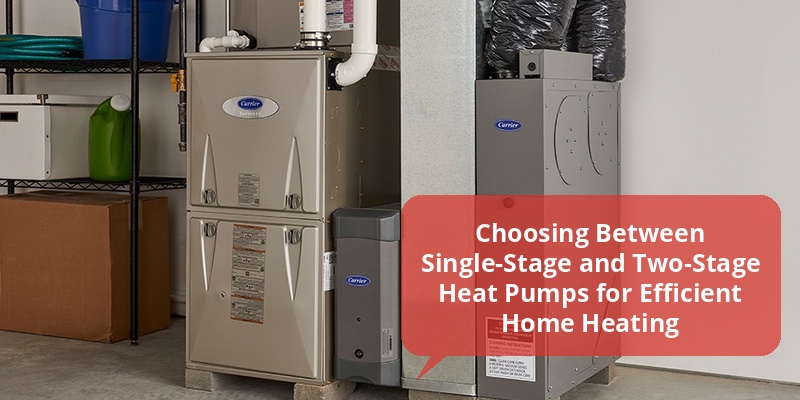Heat pumps are a popular choice for home heating and cooling due to their energy efficiency and versatility. When selecting a heat pump, a common decision is between a single-stage (1 stage) and a two-stage (2 stage) model. Understanding the differences, benefits, and limitations of each type can help homeowners make an informed choice tailored to their climate, home size, and budget. This article explores the features, performance, and cost-effectiveness of 1 stage vs 2 stage heat pumps to guide consumers toward optimal comfort and savings.
| Aspect | Single-Stage Heat Pump | Two-Stage Heat Pump |
|---|---|---|
| Operation | Runs at one fixed speed | Operates at two speeds (low and high) |
| Energy Efficiency | Standard efficiency | Improved efficiency, better energy savings |
| Initial Cost | Lower upfront cost | Higher initial investment |
| Temperature Control | Less precise temperature regulation | More consistent and comfortable temperatures |
| Noise Levels | Generally louder when running | Quieter operation on low stage |
| Ideal For | Moderate climates and smaller homes | Cold climates and larger or well-insulated homes |
How Single-Stage Heat Pumps Work
A single-stage heat pump operates with one compressor speed that runs at full capacity whenever activated. It cycles on and off to maintain the desired indoor temperature. This on/off operation is straightforward but can lead to temperature swings and less efficient energy use during mild weather.
Since the compressor is either fully on or off, the system can generate noise and consume more power during start-up. Single-stage units are often sufficient for areas with mild winters and limited heating demands. They are easier to install and have a lower initial purchase price compared to two-stage models.
How Two-Stage Heat Pumps Improve Efficiency and Comfort
Two-stage heat pumps feature a dual-speed compressor that allows the unit to run at a lower, more energy-efficient speed during mild heating or cooling needs and ramp up to full capacity on colder or hotter days. This flexibility leads to improved energy efficiency and better temperature stability throughout the home.
The low stage operates quietly and uses less electricity, reducing wear on the system and enhancing longevity. Two-stage heat pumps optimize comfort by avoiding the constant cycling characteristic of single-stage units. Because of these benefits, they are preferred in colder climates and homes where heating or cooling demands vary significantly.
Energy Efficiency and Cost Implications
Energy efficiency ratings such as SEER (Seasonal Energy Efficiency Ratio) and HSPF (Heating Seasonal Performance Factor) often favor two-stage heat pumps due to their variable speed operation. While a single-stage unit might have a SEER rating between 13-16, two-stage systems commonly achieve ratings above 16, translating to substantial energy savings over time.
Initial costs are higher for two-stage heat pumps, typically ranging from 20% to 50% more than single-stage models, depending on size and brand. However, the operational savings from reduced energy consumption and lower utility bills can offset the upfront investment, especially in regions with significant heating or cooling loads.
Noise Levels and Indoor Comfort Differences
Single-stage heat pumps often generate noticeable noise because the compressor runs at full power during each cycle. This can be disruptive in quiet environments. In contrast, two-stage heat pumps operate mostly on the lower speed, significantly reducing noise levels and delivering more consistent indoor temperatures.
The stable output prevents temperature swings and cold spots, enhancing overall comfort. Homes with open floor plans or large areas benefit most from the two-stage system’s ability to evenly distribute heating and cooling.
Climate and Home Size Considerations
Choosing the right heat pump stage should consider local climate factors and building characteristics. Single-stage heat pumps are often sufficient in mild climates where heating demands are moderate and temperature fluctuations are less extreme.
Two-stage heat pumps excel in colder climates that require longer run times and consistent warmth. Similarly, larger homes or those with high energy efficiency standards benefit from the adaptable capacity of two-stage systems, which can better maintain comfort while minimizing energy waste.
Maintenance and Longevity Comparison
Both single-stage and two-stage heat pumps require regular maintenance, including filter changes, coil cleaning, and system inspections. However, two-stage units tend to experience less stress on components because the compressor seldom runs at full speed continuously.
This operational balance can extend system lifespan and reduce repair costs. In contrast, single-stage units may face faster wear due to repetitive cycling and higher peak loads during each operation.
Choosing the Right Heat Pump for Your Home
When deciding between a 1 stage and 2 stage heat pump, homeowners should evaluate:
- Climate severity: Colder regions benefit more from a two-stage system’s efficiency and comfort.
- Home size and insulation: Larger, well-insulated homes gain from the consistent output of two-stage pumps.
- Budget constraints: Single-stage models have lower upfront costs but may incur higher energy bills.
- Noise sensitivity: Two-stage units provide quieter operation, ideal for noise-conscious households.
- Long-term savings vs initial investment: The efficiency gains of two-stage heat pumps can pay off over time.
Advancements in Heat Pump Technology
Modern heat pumps increasingly integrate variable-speed compressors beyond two stages, further enhancing precision, efficiency, and comfort. Innovations such as smart thermostats and inverter-driven technology optimize performance by adjusting compressor speed dynamically to real-time conditions.
These advancements contribute to reduced energy consumption and improved durability, marking the trend toward more sophisticated and eco-friendly HVAC solutions.
